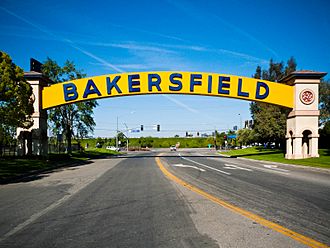Bakersfield Sign facts for kids
Quick facts for kids Bakersfield Sign |
|
|---|---|

The Bakersfield Sign, facing west on Sillect Avenue.
|
|
| Alternative names | Bakersfield Arch |
| General information | |
| Type | Sign |
| Architectural style | Arch |
| Location | Bakersfield, California |
| Coordinates | 35°23′10″N 119°02′31″W / 35.386°N 119.042°W |
| Completed | 1949 |
| Renovated | 1999 |
| Owner | City of Bakersfield |
| Technical details | |
| Structural system | Steel support |
The Bakersfield Sign is a famous landmark in Bakersfield, California. People also call it the Bakersfield Neon Arch. This big, yellow arch stretches over Sillect Avenue, near Buck Owens Boulevard. It's easy to spot from State Route 99, a major highway. You can also see it right next to the Buck Owens Crystal Palace.
The sign is a bright yellow arch with blue letters that spell out "Bakersfield." It stands on two tall towers. These towers were inspired by the design of the Beale Memorial Clock Tower. The sign uses special indirect lighting. This means the lights shine down onto the arch, making the blue letters look dark against a glowing green background. The California Neon Sign Company built this impressive sign.
Contents
History of the Bakersfield Sign
Building the First Sign in 1949
The Bakersfield Sign was first built in 1949. It originally stood over Union Avenue. This road was part of the Golden State Highway, also known as US 99. This highway was the main route connecting Northern and Southern California through the San Joaquin Valley. The Bakersfield Inn, a hotel, wanted to expand. The sign was built as a footbridge to connect the two parts of the hotel across the street.
The sign also had another important job. Many towns along US 99 had arched signs. These signs welcomed drivers as they entered the cities. The Bakersfield Sign became the city's own welcoming arch.
Saving the Sign: A 1999 Renovation
By the late 1990s, the sign was in bad shape. The Bakersfield Inn had closed, and no one was taking care of the sign. The California Department of Transportation (Caltrans) worried it might fall. They planned to take it down.
However, the original sign was carefully taken apart. A new sign and towers were built by Sampson Steel. Country music star Buck Owens played a big role in saving the sign. The new arch was stored on his property while other work was done.
The sign was rebuilt in 1999, exactly 50 years after it was first put up. On the Fourth of July, the new arch was placed next to the Buck Owens Crystal Palace. Many people came to watch. Buck Owens spent a lot of money on the project. However, many companies and workers helped by donating their time and materials. Only the original blue letters could be saved from the old sign. By rebuilding it, the sign once again became a visible landmark along the important Golden State Highway.
See also
- Modesto Arch
- Reno Arch

